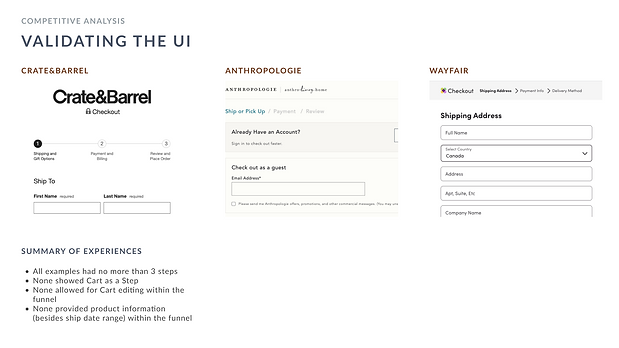
CSC Generation
Cross Brand Project
THE PROBLEM
1. An acquisition of 3 brand - Z Gallerie, One Kings Lane, and Sur la Table - meant a need for products that introduced the other as part of cross pollination selling
2. A complex product offering at Z Gallerie was configurable furniture which were not converting
ROLE
As Senior UX Designer, I was responsible for all UX research, ADA compliance, wireframing, design iterations and QA.
THE IMPACT
Increased checkout completions by 4%
THE PROCESS


DISCOVERY
User Research
Understanding the checkout funnel at competitors was a place to start to understand user expectations, since as long as they were familiar with the required steps, they would be more likely to understand how information was laid out.
To further validate this, user interviews were conducted with some insights gleaned:
1. 65% of participants found it daunting that there were 4 steps to the checkout, feeling that 2 or 3 were the most they had seen in the market.
2. Customers who were not purchasing an item with white glove delivery were still presented this as a step on the delivery tab, even when having no selection to be made. This added unnecessary friction.
3. Users were not able to edit their cart without leaving the checkout, resulting in skewed abandonment data.

Journey Flows
Understanding the user journey was then included to illuminate any areas of friction and various requirements that would need to be considered for different types of users. Whether or not someone was a logged in customer or a guest, what data would be retained, when they were required to input mandatory information, etc.
IDEATION
Site Design Strategy
Refining the checkout to match the users expectations while maintaining the requirements of 3 brands was a unique and risky challenge, being the last and most crucial step in the purchasing journey.
A Design System was created in tandem with this project to ensure well defined brand identities and UI consistency.

Product Page Optimization
The product page was also redesigned to reflect this new Design System and support categories within the brand that were under performing. The main one being customizable furniture, where each modular furniture piece was relegated to its own PDP even when a user is trying to build out one cohesive sofa. This meant they were not able to see each piece come together or which elements they had already configured, adding substantial friction.
This category being the most complex needed the most amount of variants, so I reverse engineered the product page to this most complex layout, with the ability of removing components to simplify the page for products with the fewest variants.
A Before and After below


Design System
The elements on this page needed to support many different types of variants which required a Design System in addition to the standard UI Kit provided to the engineering team. Ensuring options were built as new categories were considered, functionality requirements were captured, compliance was accounted for and all edge cases were addressed was integral to the success of this product.

